How to Optimize for AI Search Results in 2025
To optimize for AI search results in 2025, focus on making your content easily discoverable, citable, and trusted by AI systems such as ChatGPT, Perplexity, Mistral, and Google AI Mode. Start by ensuring your site is crawlable for AI bots, structure your content for direct answers, and include verifiable data, examples, and sources that large language models can reference.
Improving your AI visibility also requires regular testing across major platforms to see where your brand appears and how it is being cited. Tools like Superlines help track and improve this visibility over time by showing which pages are already cited in AI answers and which need optimization, making AI performance measurable and actionable. By optimizing for AI search now, brands position themselves where customers actually make decisions, inside the conversations that guide their choices.
Search behavior has changed dramatically. Users now rely on conversational tools instead of typing keywords, expecting AI systems to summarize and compare information instantly. As a result, visibility now depends on whether AI models retrieve and cite your content when they generate answers, not just whether you rank in Google.
In this comprehensive guide, you will learn how AI search works, how large language models decide what to cite, and what brands can do to improve their presence across ChatGPT, Google AI Mode, Perplexity, and other major platforms. You will also see real examples, metrics, and tools that help you measure and strengthen your AI visibility over time.
What Is AI Search Optimization?
AI search optimization is the practice of making your content more likely to be referenced, cited, and recommended by large language models (LLMs) across leading AI search platforms such as ChatGPT, Google AI Mode, Perplexity, Mistral, and Microsoft Copilot.
Also called Generative Engine Optimization (GEO) or Answer Engine Optimization (AEO), it focuses on earning citations and visibility inside AI-generated answers rather than traditional search results.
Each major platform now produces AI-driven summaries that consolidate information from multiple sources:
- Google AI Mode and AI Overviews: Generate summaries that appear above organic results and highlight cited sources.
- ChatGPT: References trusted content within responses to user prompts and comparisons.
- Perplexity: Attributes facts to verified domains in research-style queries.
- Mistral: Powers an expanding set of European enterprise AI assistants and web-connected agents.
- Microsoft Copilot: Displays contextual citations within conversational search experiences.
Success in AI search means understanding how these systems retrieve, prioritize, and cite sources, and structuring your content so it becomes their preferred reference.
For a complete framework on integrating GEO into your SEO strategy, explore our Generative Engine Optimization (GEO) Guide for 2025.
How AI Search Differs from Traditional SEO
Traditional SEO optimizes for search engine rankings. AI search engine optimization optimizes for mentions and citations.
The nuanced differences between AI search and SEO can be confusing. And it’s leaving many marketers wondering whether the methods used to optimize for each are really different in practice.
There has even been large-scale clashing on Linkedin between SEO and the GEO/AEO experts with many declaring the other party to be wrong and ridiculous. The truth sits somewhere in between: SEO provides the technical foundation, while GEO extends it into AI-driven discovery. I wrote a post about this recently, aiming to clarify where SEO ends and where GEO begins, and how both are essential for visibility in the AI search era.

Think of it this way: AI systems now act as intermediaries between users and content, filtering and synthesizing information rather than just linking to it.
This changes how people search and consume information:
People ask full questions. Instead of "email marketing tips," they ask "What's the best way to increase email open rates for B2B companies?"
AI provides complete answers. Users get comprehensive responses without clicking through to multiple websites.
Brand awareness matters more than traffic. Being cited builds authority even when users don't visit your site.
Multiple sources get combined. AI pulls information from several websites to create one answer.
All of these differences mean you need to write differently. Focus on being easily referenced and cited rather than just comprehensive.
Why AI Visibility Is the Next SEO Frontier
AI visibility is the next SEO frontier for several reasons. First, AI search is growing in an explosive manner. ChatGPT alone boasts over 1B queries a day and has over 800 million weekly active users.
AI Overviews now appear on 13% of searches, doubling in just two months, according to Semrush' AI Overviews research.
Share of queries triggering AI Overview grows from 6.49% in January 2025 to 13.14% in March 2025.
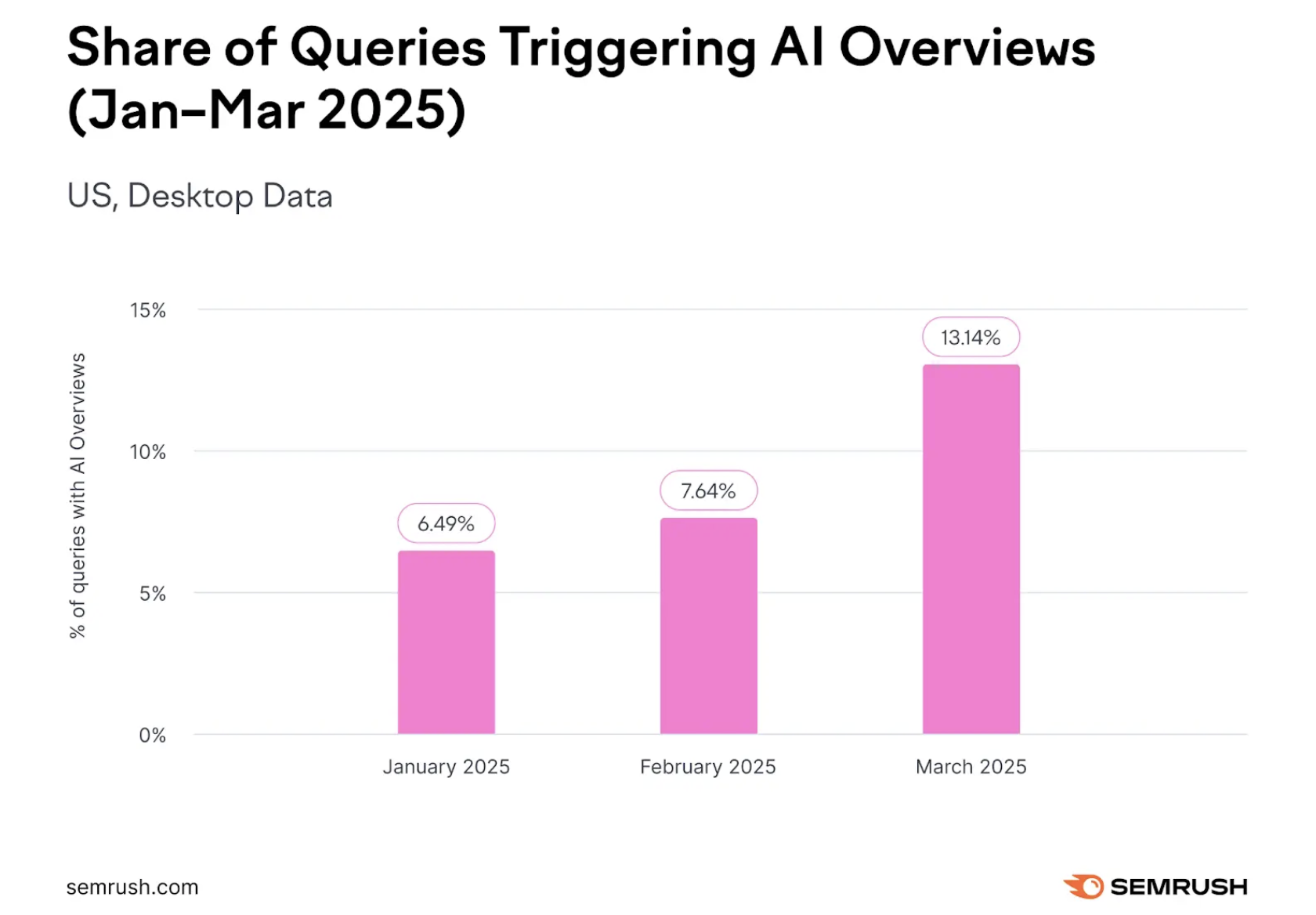
ChatGPT gained 8x more weekly active users since October 2023. Perplexity is becoming the go-to research tool. Google's AI Mode is rolling out to millions more users every week now.
But here's the stat that changes everything: AI search visitors convert 4.4 times better than traditional organic visitors.
By the time someone finds you through an AI citation or mention, they're educated about your solution and closer to making a decision.
Example how AI mode shows the direct answer and even where to buy:
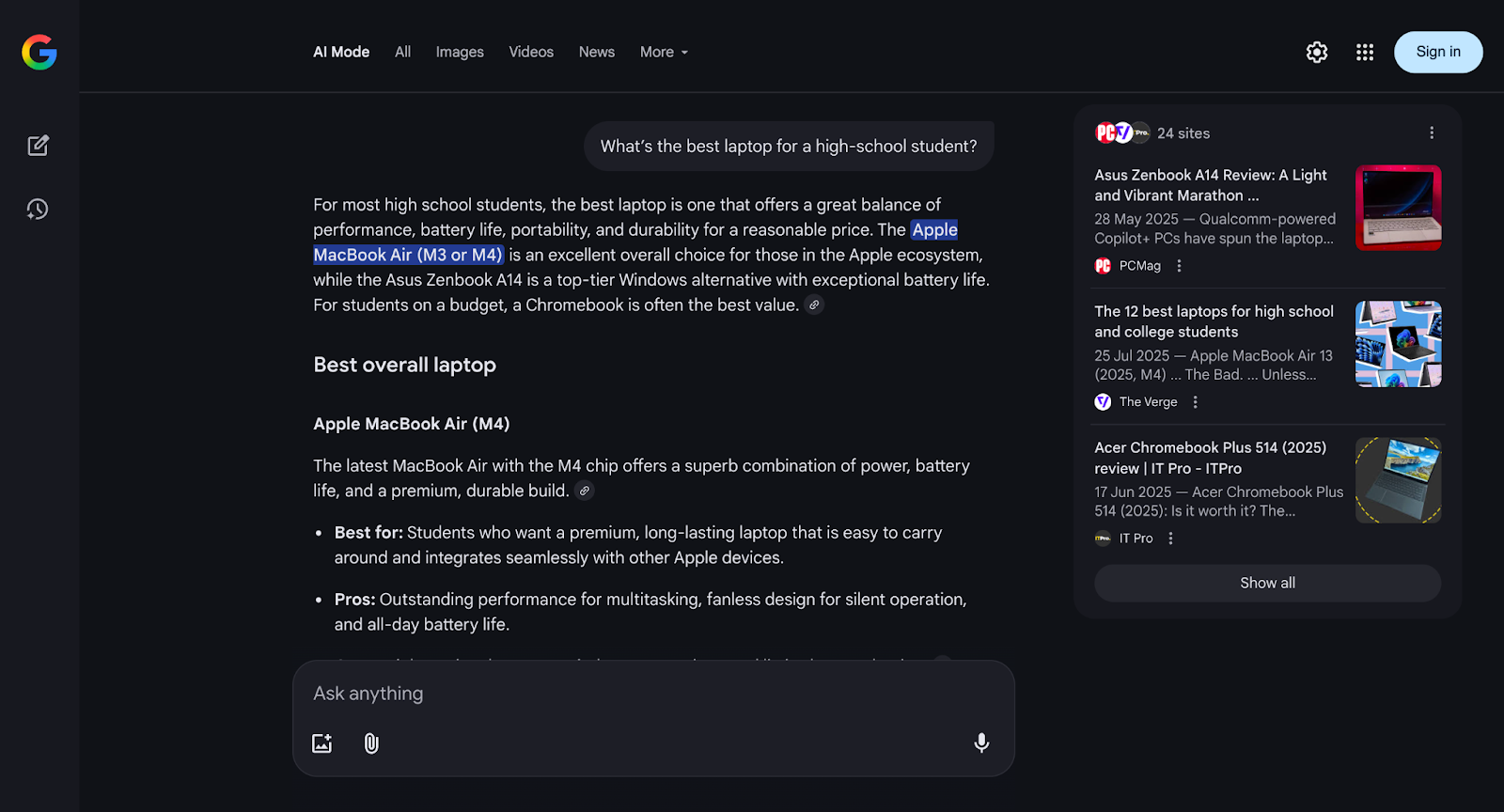
Example how the same question is shown in traditional search:
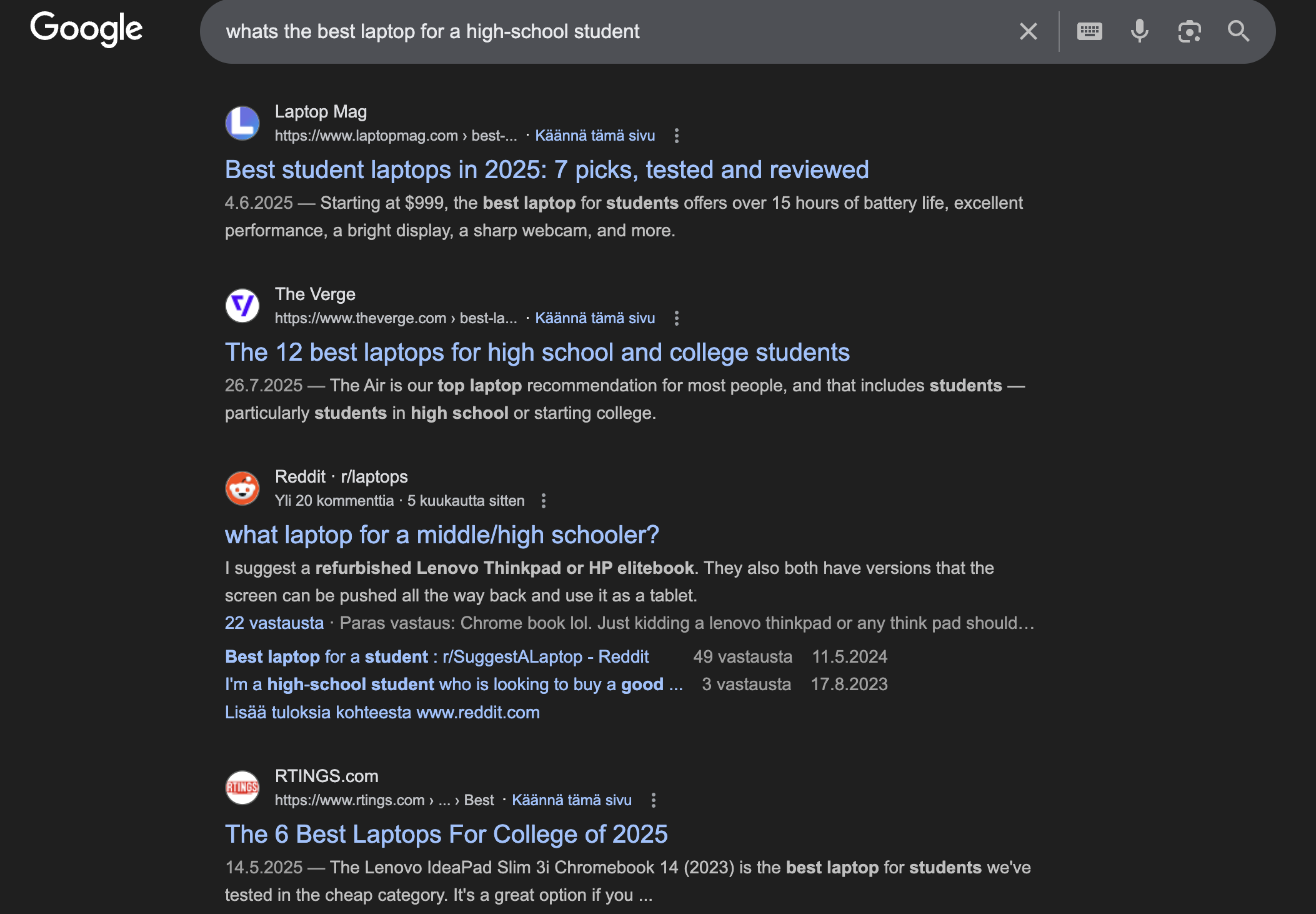
A traditional Google search gives the user a page with blue links to comb through while AI search synthesizes information into a digestible format.
And the opportunity is massive.
Right now, AI search represents a largely untapped channel. While traditional SERPs are saturated with competition, AI platforms are citation-hungry, and the field isn't crowded yet.
This means there’s an unprecedented opportunity for newer or smaller brands to gain visibility by optimizing specifically for AI. Even the bigger established brands should look into AI Search as a means to capture market share from competitors. Companies optimizing for AI visibility now may capture this higher-intent traffic while competitors fight over declining traditional search volume. The window won’t stay open forever, but you don’t need to overhaul everything to start. Before optimizing, understand your current visibility and how AI systems interpret and surface your brand.
Audit Current AI Visibility and Sentiment
Use a tool like Superlines Answer Engine Insights to benchmark your visibility score, share of voice, and sentiment trends.
Analyze which AI platforms mention your brand, how often, and in what context.
Look for both positive and negative sentiment to understand how your brand is perceived by AI engines even though LLMs are most of the time positive or neutral. This audit will reveal your current standing and highlight areas for improvement.
How AI Search Works (Simplified)
AI search engines use a process called Query Fan-Out, where they split one question into multiple sub-queries, gather sources, and combine them into an answer.
Your goal is to make your content one of those cited sources.
For a deeper technical breakdown of Query Fan-Out and how it shapes AI citations, see our What Is Query Fan-Out? guide.
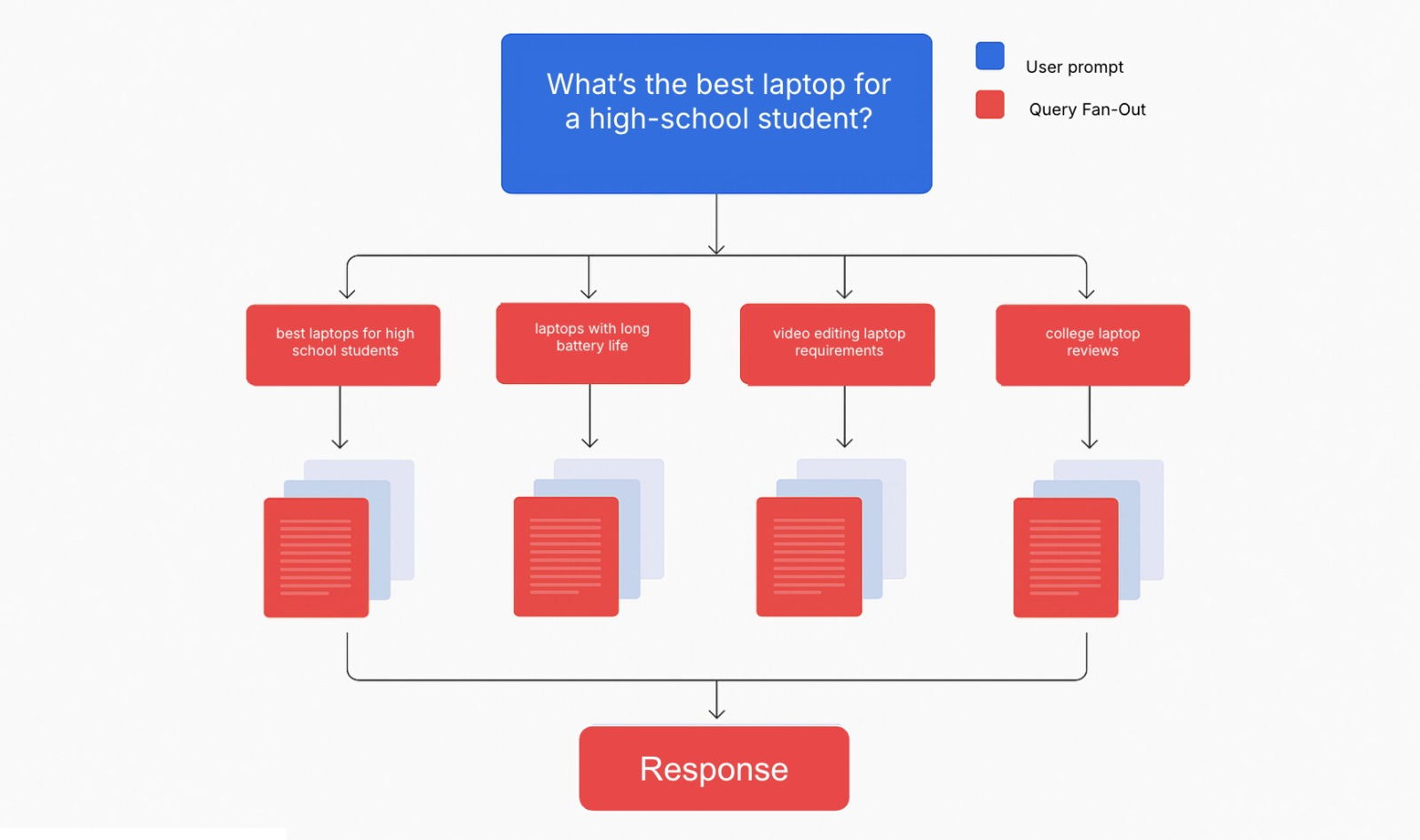
Understanding how AI splits and merges queries is crucial. Your goal is to become one of the few high-authority domains that consistently appear across those sub-queries.
Best Practices for AI Search Keyword Research
(and why most teams get this wrong)
One of the most common questions marketers ask is:
“What are the best practices for AI search keyword research?”
The single biggest shift is this:
AI keyword research is no longer guesswork. It depends entirely on the LLM’s actual query fan-out.
Most teams still generate “AI keywords” using ChatGPT or Gemini by prompting them to “suggest keywords.”
But Superlines’ internal testing and customer data show that:
Assistant-suggested keywords perform up to 75 percent worse than the real LLM keywords extracted from actual retrieval.
In other words, the keywords AIs say they use and the keywords they actually use are often very different.
Here is the correct workflow.
1. Start with real user questions, not short SEO keywords
Instead of researching “email marketing” or “B2B CRM software,” begin with natural language prompts like:
- “What is the most effective CRM for a startup sales team?”
- “How do I optimize email sequences for higher B2B open rates?”
This mirrors how modern AI search works.
2. Capture the real AI search keywords (LLM keywords)
This is the crucial step.
AI engines break your prompt into multiple retrieval queries.
These hidden retrieval queries are the real AI search keywords.
Superlines captures these fan-out queries directly from the retrieval behavior across ChatGPT, Perplexity, Gemini, and other LLMs.
These are not:
- SEO keywords
- Assistant-generated keyword ideas
- NLP keyword clusters
They are the actual search terms AI uses to fetch content.
This is the deepest layer of intent matching available in AI search.
3. Build content that mirror those LLM keywords
Once you know the real fan-out keywords driving retrieval, your content instantly becomes more “fetchable” for AI systems.
This accelerates:
- Brand Visibility
- Citation Rate
- Share of Voice
- Correct brand representation inside AI answers
Most importantly, it shortcuts months of guesswork.
4. Watch your AI visibility jump within days—not months
Teams using Superlines for data-backed GEO typically see:
- Immediate increases in citation frequency
- More consistent mentions across ChatGPT and Perplexity
- Higher ranking in multi-source AI summaries
- Faster recovery of lost visibility compared to traditional SEO updates
When you optimize for the real LLM keywords, you align your content directly with how AI retrieves information today.
How AI Platforms Decide What to Cite
Each AI engine has its own citation logic. ChatGPT and Gemini use multi-source retrieval and look for clear structure and factual alignment, while Perplexity favors sources with domain authority and transparency.
In practical terms, this means your content needs to combine freshness, factual precision, and authority signals (like author bios and clear sourcing) to earn citations across engines.
AI systems typically weigh three core dimensions when selecting sources:
1. Authority: Domain and author credibility based on historical mentions, E-E-A-T factors, and external signals.
2. Freshness: Recency of publication and update timestamps.
3. Factual consistency: Alignment of claims across multiple verified sources.
Superlines’ data as well as Semrush’ confirms that pages combining all three factors are up to 4.7× more likely to be cited across engines like ChatGPT and Gemini.
How to Optimize for AI Search Engines
You don't need to overhaul your entire content strategy to start getting AI citations. In fact, you shouldn’t. Because many of the same concepts apply: writing high-quality content, making your content easy to understand, etc.
That said, here are six quick ways to improve your AI visibility this week.
1. Verify AI Systems Can Access Your Content
Before optimizing for citations, confirm that AI crawlers can actually reach your pages.
Check your robots.txt file at yoursite.com/robots.txt. Look for blocks against common AI crawlers like:
Claude-Web (Anthropic)
GPTBot (ChatGPT)
CCBot (various AI systems)
If you see Disallow: / for these crawlers, you're blocking AI access.
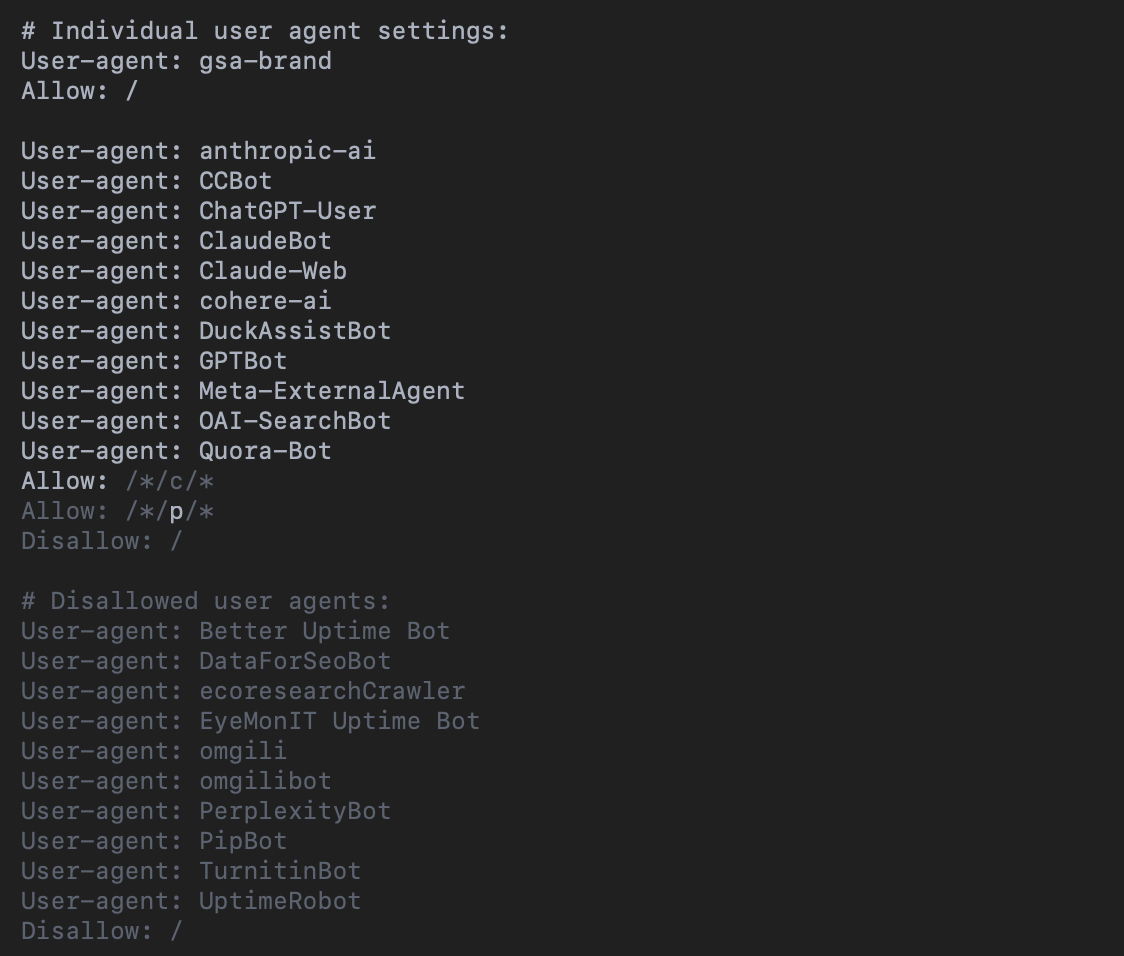
A website allows most AI crawlers but disallows others in their robots.txt file.
Quick verification: Search for your brand name or key topics on ChatGPT, Perplexity, and Claude. If your content never appears as a source, you may have accessibility issues.
Example: Allowing All Crawlers

If you don’t want to block or restrict any AI crawlers, you can simply use an Allow All configuration in your robots.txt file. This ensures that your website’s public content is accessible to both traditional search engines and AI systems. This approach is suitable for most websites that want maximum visibility across AI and traditional search platforms.
Check that your most important pages aren't blocked by:
- Login walls or paywalls
- JavaScript-only navigation that crawlers can't follow
- Missing or broken canonical tags
- Server errors or extremely slow loading times
Quick action: Test 3-5 of your top pages by searching for their exact titles on AI platforms. If none appear as sources, investigate your technical setup.
Next, optimize technical signals like structured data, schema markup (Article, FAQPage, HowTo), and load speed. These technical elements help AI engines crawl, interpret, and quote your content correctly.
2. Add Specific Statistics to Your Best Content
Start with 2–3 articles that already rank well for your target keywords.
Replace vague statements like “many businesses struggle with email marketing” with concrete data such as:
“Email marketing generates €39 for every €1 spent, according to HubSpot’s 2024 research.”
Our analysis of AI citations shows that content with specific, sourced statistics gets referenced more often than vague generalizations.
For example, a Superlines article cites a Gartner study stating that “many brands will see their site traffic from organic search decline by 50% or more as consumers shift toward generative AI-powered search.”
The citation is embedded directly within the text as a contextual hyperlink, which is a simple but powerful optimization.
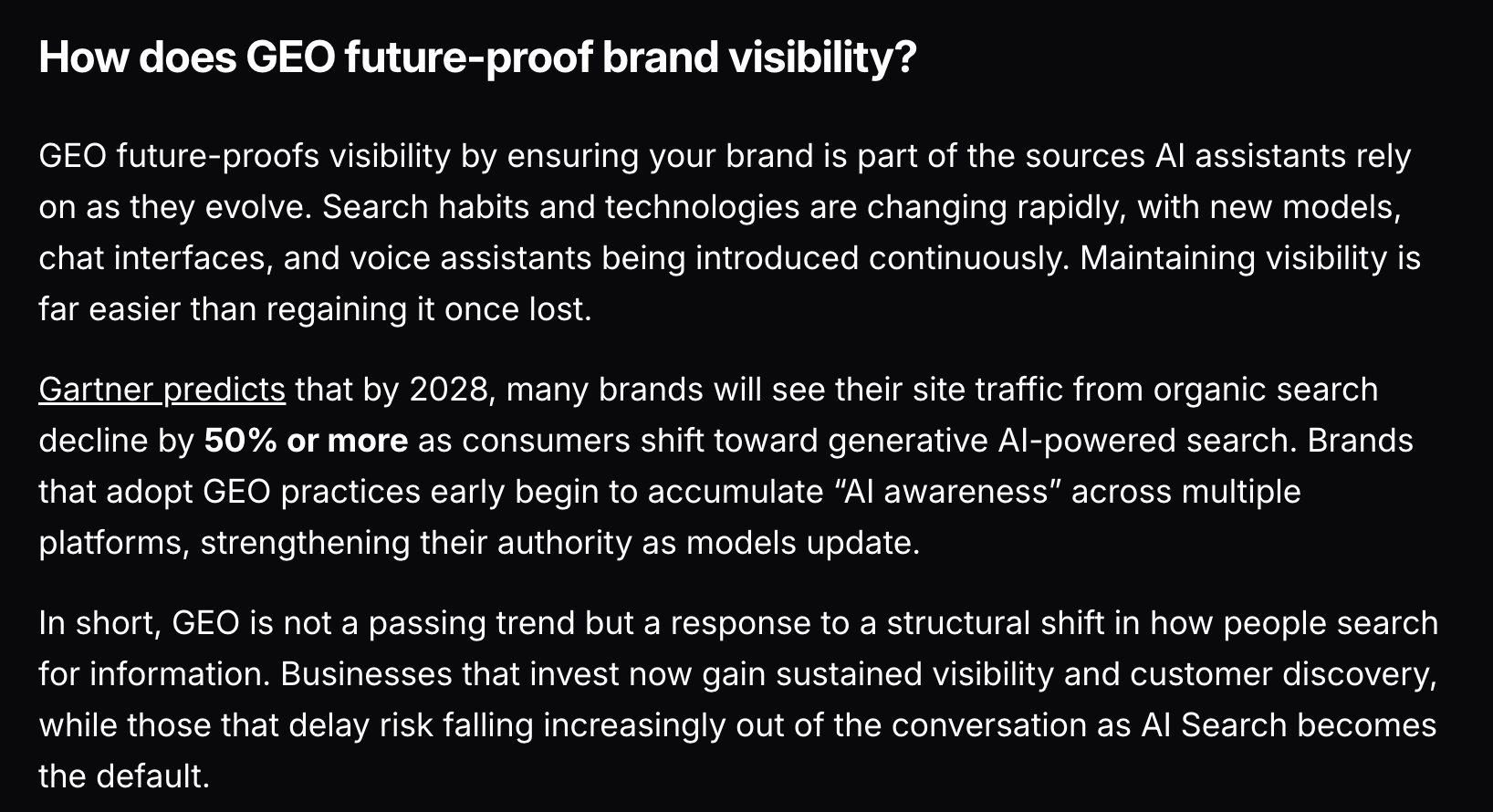
This single change often produces the fastest gains in AI citation frequency.
It also helps AI models and human readers instantly verify that your information is credible and current.
Many creators let AI generate citations automatically, but it is essential to verify every source manually. In several cases, even major publications have quoted studies that do not actually exist after multiple layers of second-hand referencing. Always double-check the original source before publishing, as it builds long-term authority and prevents misinformation loops.
Quick action: Spend 30 minutes finding 2-3 relevant statistics for your top-performing articles and add them with proper attribution.
Pro Tip: Sources with outbound links to first-party research or government datasets get cited more often because AIs can trace fact origins.
3. Test Your Topics on AI Platforms
AI platforms like ChatGPT, Perplexity, and Google’s AI Mode have become the new front door to discovery. To optimize for them, start by asking the same questions your audience would at each stage of their journey.
Think of it as funnel testing:
- Discovery phase: “What is…” or “How does…” queries that surface educational and top-funnel content.
- Evaluation phase: “Best X for Y” or “Top tools for…” questions that compare solutions.
- Decision phase: “Pricing,” “reviews,” or “alternatives” queries that reflect purchase intent.
Run these prompts directly on ChatGPT, Perplexity, Copilot, and Google AI Mode.
Note which competitors get cited and what types of sources appear. If your brand is missing, you’ve found a content gap.

Example:
From the image above, you can see how Google AI Mode cites multiple sources for the query “How to optimize email campaigns.” In this case, the AI selected content from Klaviyo and Campaign Monitor but not HubSpot.
If I were working on HubSpot’s marketing team, this would immediately reveal a content gap. I’d analyze the cited pages to understand what they do differently, such as the structure of their subheadings, the use of examples, or how clearly they answer the question. Then, I’d revise or expand HubSpot’s article to better match the search intent and ensure it becomes a candidate for citation in future AI responses.
Pay attention to how AI systems phrase their responses; the tone, structure, and type of formatting they prefer. Then mirror these elements in your own content.
If AI-generated answers often use numbered lists or start with direct definitions, incorporate that style into your articles to increase extractability.
Quick action:
- Test five prompts related to your main topic across major AI platforms.
- Document which sources get cited and analyze what they do differently.
- Identify patterns, such as whether they use structured headings, schema markup, or unique data formats.
- Add one successful structural element from those top-cited pages into your next piece of content.
Common Mistake: Optimizing only for one platform. ChatGPT, Perplexity, and Gemini each evaluate authority differently; diversify your format and structure.
4. Structure Content for Direct Answers
Write content that answers questions completely within standalone sections. Provide the direct answer first instead of building suspense or burying key information deep in the text. Use question-based headings like “What is Generative Engine Optimization?” rather than vague titles like “GEO tips.” AI systems extract 300–600-word content chunks that must make sense without extra context from the rest of the page.
Example: If your heading is “What Is Generative Engine Optimization?” start with a one-sentence answer such as:
“Generative Engine Optimization (GEO) is the process of optimizing content so that AI systems can understand, reference, and cite it within their generated responses.”
Then expand with supporting details, statistics, and examples:
“Instead of only chasing rankings in traditional search, GEO structures your content and presence across trusted sources so AI assistants can reliably reuse, attribute, and cite you. According to OpenAI’s July 2025 research, 700 million people now use AI assistants weekly, sending an estimated 18 billion messages. This shows why inclusion in AI answers is critical.”
This clear, front-loaded structure makes your sections more likely to be selected and cited as part of AI-generated responses.
Like this:
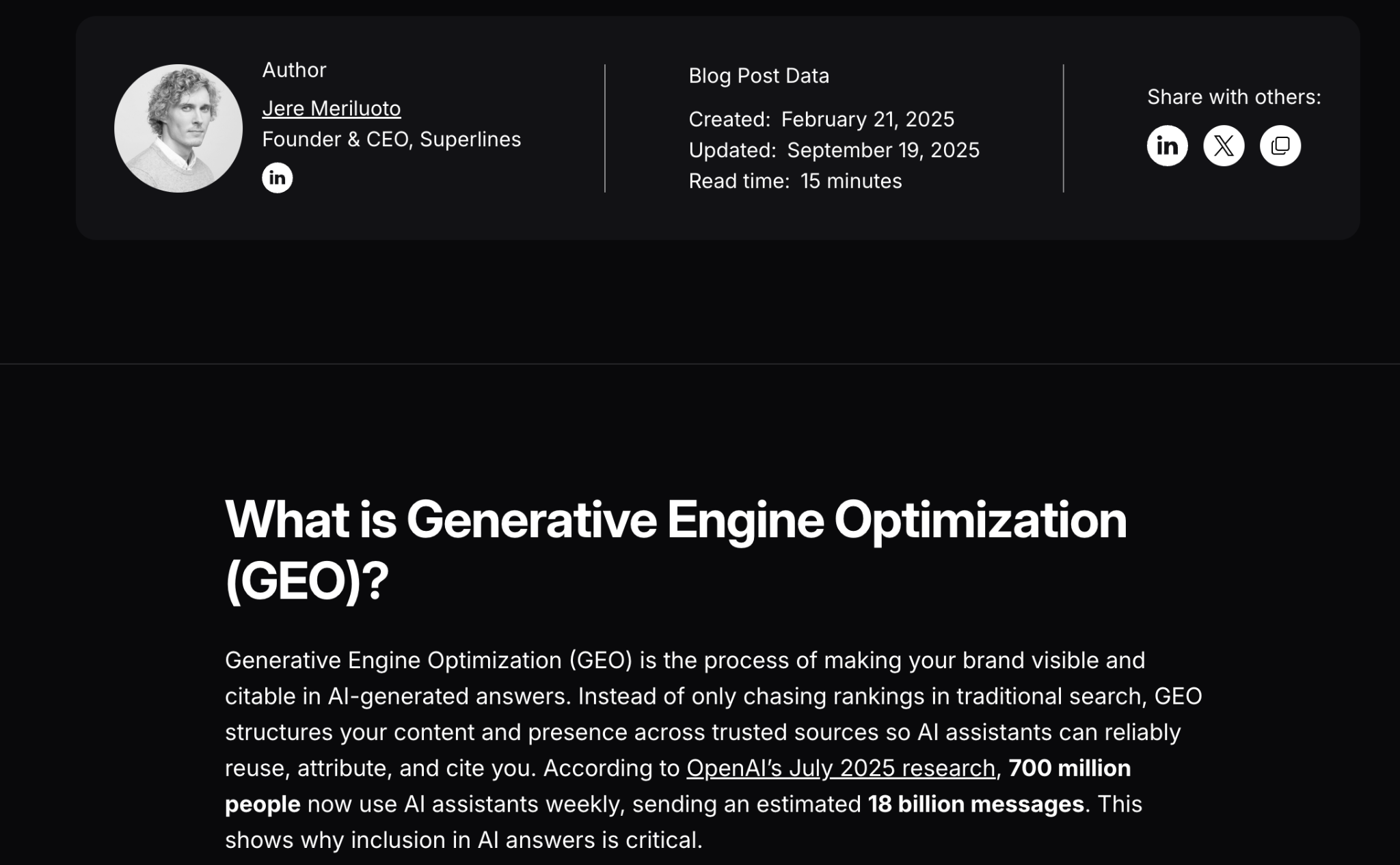
Quick action: Rewrite the headings in one existing article to directly answer questions your audience asks. Then make sure the opening paragraph under each heading provides a complete answer before expanding on details.
Pro Tip: Add TL;DR summaries, FAQs, and bullet lists under each main topic. These make your content easier for AI models to parse and cite accurately. One way to do this is to naturally embed your H2s and H3s into question format and provide answers instantly. This way you don’t have to separately create FAQ sections in the middle of the article since it can hurt the overall UX and looks funny.
The most frequently cited sources are those publishing original insights or unique data. Establish your brand as a thought leader by creating data-backed, first-party research.
5. Make Yourself Easy to Quote
AI systems excel at creating generalizations by synthesizing multiple sources, but they need specific data points and examples to cite as evidence. Include expert quotes, case study results, and concrete examples AI systems can extract and cite.
Generic statements like "Our approach works well" don't provide the concrete details that make content citation-worthy.
We improved our AI visibility,” write: “After adding structured FAQs and TL;DR summaries to 20 key articles, our brand citations in ChatGPT increased by 36% within one month.
You can apply the same logic to other performance metrics, whether that’s engagement rate, conversions, or visibility growth. The key is to provide verifiable, time-bound outcomes that AIs can confidently cite as factual examples. The specific numbers, timeframe, and measurable outcome give AI systems something concrete to reference when supporting broader claims about website performance.
Beyond quotable content, establish yourself as a quotable source.
Add your credentials and experience to author bios. AI systems may look for authority signals when deciding which sources to cite.

This principle applies across industries, from marketing to SaaS to enterprise AI. Being visibly connected to your insights increases both human trust and algorithmic credibility
For example, a SaaS founder’s author bio should include structured schema data, links to verified social profiles, and references to measurable company impact within their industry.
These changes won't transform your AI visibility overnight, but they create the foundation that makes other optimization techniques more effective.
Start with the statistics; it's the highest-impact, lowest-effort improvement you can make. When AI systems evaluate who to cite, they often favor sources tied to verified professionals with consistent topical authority — exactly what an optimized author schema and bio achieve.
Pro tip: A great way to increase your chances of getting your content cited as a source is also to embed rich elements into your content. AI loves these as they can easily extract these directly into the conversations.
If you'd like to understand on a deeper level about the best practices on how to optimize content for Generative AI, we recommend to read our guide on that.
6. Keep Your Content Updated (The Recency Bias)
Regularly updating your content is a traditional SEO technique that remains critical for AI search visibility, not necessarily because newer always means better, but because AI systems tend to retrieve what’s most accessible and clearly indexed at the time of query.
You can see this pattern when you perform searches that trigger an AI Overview. Even evergreen queries often include a mix of older and newer content, but the newer pieces frequently dominate because they are easier for AI crawlers to fetch, parse, and verify.

Example: In Google’s AI Overview for “best training activities for young adults”, results included articles from 2025 only. This suggests that freshness and technical retrievability, not just publication date, play a major role in visibility.
Metehan Yeşilyurt, Co-Founder and Chief Growth Officer at AEO Vision, summarized this dynamic well in a recent LinkedIn post:
“ChatGPT prioritizes RECENT over PERFECT. That amazing guide from 2022? It’s losing to mediocre content published yesterday.”
That observation reflects how LLM-based search favors discoverability and current context over legacy authority. In other words, if an older article isn’t structured or indexed in a way modern AI systems can interpret, it may simply be invisible regardless of quality.
Prioritize updating and re-indexing your most important content, especially pages that have lost visibility. Use Google Analytics 4 to find underperforming pages, and strengthen them by:
•Incorporating new statistics and credible sources
•Updating discussions to reflect the latest developments (for example, model updates or platform changes)
•Adding recent data or insights (such as 2025 research or customer surveys)
Once your pages are technically sound and structured for AI readability, the next step is to measure how visible your brand actually is across LLM-powered search engines.
How to Measure Your Current AI Search Visibility
Tracking AI visibility is what separates guesswork from strategy. Start by identifying which LLMs cite your content most frequently, where your brand appears, and what context it’s mentioned in. Tools like Superlines provide brand visibility dashboards that show citation frequency, share of voice, and sentiment trends across AI engines.
Even a simple baseline measurement (such as number of brand mentions across ChatGPT and Perplexity) helps you benchmark progress as you optimize.
Best Tools to Monitor and Optimize AI Search Visibility
Manual testing is a great start, but scaling visibility tracking requires purpose-built GEO analytics tools.
For continuous measurement, you need tools that monitor your brand’s visibility, track sentiment, and benchmark citations across multiple AI systems in real time.
1. Superlines

Superlines is one of the most comprehensive purpose-built GEO analytics platforms on the market, designed for teams that want real-time visibility into how their brand appears across ChatGPT, Perplexity, Google AI Mode, Mistral and other AI platforms. It combines simplicity with depth, offering clear insights, competitive benchmarking, and advanced visualizations that turn AI search data into growth opportunities. The platform stands out for its transparency, allowing users to see exactly how data is gathered and interpreted, and for its thoughtful service design, which emphasizes clarity over complexity.
Key Features:
- Answer Engine Insights: Comprehensive brand visibility tracking across ChatGPT, Perplexity, Gemini, and other major AI platforms, with geographical tracking and competitor benchmarking included.
- Prompt suggestions from real data: Live monitoring of trending topics and user query patterns across search and online sources, removing the need for users to know which prompts to track.
- Advanced crawling: Domain-level crawling with optimization suggestions to improve your AI Search visibility.
- Dedicated GEO expert Support: Tailored recommendations and optimization playbooks designed specifically for Enterprise clients.
Pricing: Starting at €89/month with flexible example packages for marketing teams and enterprises to choose from. All packages can be customized for customers needs.
Limitations: Attribution modeling is available only via GA4, and server-side tracking is limited to selected Enterprise clients.
2. Profound

Profound has evolved from a promising GEO platform to a market-defining company pioneering the concept of "marketing to Superintelligence." Its $35M Series B funding (right after their $20M Series A in June of 2025), led by Sequoia Capital, positions it as the definitive solution for organizations serious about preparing for an AI-first marketing future.
Key Features:
- Answer Engine Insights: Comprehensive brand visibility tracking across ChatGPT, Perplexity, Gemini, and other major AI platforms
- AI Crawler Analytics: Agent Analytics reveals how AI crawlers access your content, provides a technical analysis to ensure your site is optimized for AI indexing, and uses a GA4 integration to attribute traffic and conversions to AI search.
- Shopping Intelligence: Shopping Insights shows your products' visibility in ChatGPT identifies keywords to target, analyzes competing products and retailers, and helps you refine how your products are represented.
- Conversation Explorer: Live monitoring of trending topics and user query patterns across AI platforms
- Content Workflows: Automated content creation and optimization pipelines for AI visibility
Pricing: Starting at $499/month for the Standard plan, with custom enterprise pricing available.
Limitations: Premium pricing makes it inaccessible for smaller businesses. Setup complexity requires dedicated technical resources.
3. Promptwatch

Like the name of the product says, Promptwatch tool helps you track brand mentions across AI platforms, helping companies understand how they're portrayed by AI Search engines.
Key Features:
- Prompt tracking: Track brand mentions across AI models
- AI traffic attribution: Identify which AI models drive traffic and conversions, and tie outcomes back to pages and content.
- Content optimization: Receive content optimization suggestions
- Looker studio integration: Allows you to view your data in Looker studio
Pricing: Starting from $75/a month with Professional and Business options.
Limitations: Platform itself isn’t as actionable as it could be and to get everything out of the platform you are required to have technical implementation skills and required to send server logs for them to attribute traffic.
When Free Testing Isn’t Enough
Free prompt testing across AI platforms is a good start. But as soon as you monitor 10+ topics or competitors, it becomes unmanageable.
That’s when purpose-built GEO analytics platforms like Superlines, help automating monitoring, reporting, and alerting for brand mentions, sentiment, and AI visibility trends.
Once you have chosen your AI visibility tools, the next step is knowing how to use them effectively to drive measurable improvements instead of just collecting data.
How to Use GEO Tools Like Superlines Effectively
Once you have selected a GEO platform such as Superlines, the real value begins after the first visibility report. As marketers, we do not want data for its own sake. Insights only matter when they lead to faster, better decisions. That is why Superlines has been designed as the most actionable solution in the market—built to turn analysis into measurable results, not more time spent analyzing dashboards.
Here’s how to use those insights to strengthen your visibility and performance in AI search:
1.Track your prompts daily
Monitor your core prompts every day to see which content pieces AI systems currently select as top citations. This shows what LLMs view as the most relevant and trusted answers in your category.
2.Analyze what is winning and why
For each prompt, determine whether the top-cited pages are highly optimized or ranking simply due to lack of competition.
•If a page is already strong, build a more detailed and structured version supported by fresh data and schema.
•If the ranking page is weak or outdated, you can win quickly by publishing a better optimized and more comprehensive article.
3.Adjust and measure in real time
GEO platforms like Superlines make it possible to see how every update impacts your visibility. When you refresh content or publish something new, you can measure within days whether your changes improved citations and AI coverage.
4.Create a continuous feedback loop
This process; analyzing, improving, and validating, creates a continuous feedback loop that accelerates learning and reduces time to action. Superlines is built to support this workflow end-to-end, helping marketers spend less time interpreting data and more time executing changes that grow their visibility and results.
Here’s a simple action plan for you to start before you have a dedicated tool
Today (30 minutes):
Find 2-3 statistics for an article that could use more authority and add them with sources
Ask ChatGPT and Perplexity one question your audience would ask about your topic, then note which competitors get cited and what language patterns the AI uses
This week:
Rewrite 3-5 key headings in one article as direct questions. Then ensure the first paragraph under each directly answers the question
Add one specific case study or example to your author bio
Test whether competitors appear when you search your topics on AI platforms. Then identify one element from the most-cited sources that you can adapt for your content
That's it. Start with these five actions before diving deeper.
Advanced GEO Strategy: Strengthen Topic Authority Through Entities
Once you’re tracking your AI visibility, identify which topics your brand gets cited for. Then, create supporting content that reinforces those entities, like glossaries, FAQs, and definitions.
Most important part is to take action
The more consistently an AI engine sees your brand associated with a topic cluster, the more likely it is to treat your content as a canonical source in future answers.
This guide will remain relevant as new AI models and search interfaces evolve; the principles of visibility, authority, and accessibility apply across all future LLM-based platforms.
The next phase of search is already here and visibility depends on how AI systems understand and cite your content. As AI systems become the primary discovery layer, visibility will shift from pages and rankings to citations and mentions. Brands that treat AI search as a measurable, optimizable channel will dominate awareness in the same way early adopters of SEO did two decades ago.
For a deeper, strategic breakdown of how to operationalize these tactics inside your marketing team, see our 10-Step GEO Guide for 2025.
The future of search belongs to brands that understand how AI sees the web. Start optimizing for visibility inside answers, not just rankings and you’ll define how your market discovers you.
Start tracking your brand’s AI search visibility with Superlines today to see where you already appear and where untapped opportunities still exist across ChatGPT, Perplexity, and Google AI Mode.
.svg)
.svg)
.svg)
.svg)


